|
| Our Peer Accepted and Published Articles |
|---|
|
Precision Posterior Intradiscal Placement For Lumbar Endoscopic Partial Discectomy Procedures. ASRA Nov. 2019 New Orleans, LA
|
|
|
Paramedian lumbar endoscopic spinal canal fragmentectomies without bone removal - long term follow-up. EANS Sept. 2019 Dublin, Ireland
|
|
|
Endoscopic Discectomy and Reconfiguration at L5-S1 - Long Term Follow-up. ISASS 19th Annual Conference, April 2019. Anaheim, California.
|
|
|
Nano Endoscopic Approach for Central Lumbar Disc Herniations. Poster presentation at The International Society for the Advancement of Spine Surgery in Boca Raton, FL USA | April 12 - April 14, 2017.
|
|
|
Removal of Disc Fragments from the Lumbar Spinal Canal Without Normal Anatomy Disruption. Spine Summit 2016. The 32nd Annual Meeting of the Section on Disorders of the Spine and Peripheral Nerves, March 2016. Orlando Florida.
|
|
|
Paramedian, Zero Trauma Approach Through the Ligamentum Flavum for Extruded Disc Herniations in the Lumbar Spine. Contress of Neurological Surgeons Annual Meeting, Sep 2015. New Orleans, Louisiana
|
|
|
Endoscopic Anterior Cervical Discectomy Without Fusion Through a Two Millimeter Opening. ISASS Annual Meeting, May 2014
|
|
|
Multifactorial Lumbar Stenosis Treated Successfully with Primary Factor Treatment Only. The 2012 AANS/CNS Section on Disorders of the Spine and Peripheral Nerve Annual Meeting , Mar 2012. Orlando Florida.
|
|
|
"Lumbar Fusion Candidates" Avoid Fusion: Long Term Follow-up. The Congress of Neurological Surgeons 2011 Annual Meeting, Oct 2011
|
|
|
NON-TRAUMATIC, TRANS-LIGAMENTUM FLAVUM APPROACH FOR L5/S1 EXTRUDED DISC HERNIATIONS. Annual Meeting of the AANS/CNS Section on Disorders of the Spine and Peripheral Nerves, Feb 2010.
|
|
|
Double Approach Non-traumatic Lumbar Spine Surgery in Central and Paracentral Lumbar Disc Herniations: No Access Surgical Trauma, Better Results and No Failed Back Surgery Syndrome. IITS 2009, Phoenix
|
|
|
Treatment of central and paracentral lumbar disc herniations with a transforaminal double access non-traumatic discectomy: safe and with better results. WCMISST June 2008
|
|
|
7 cases with previous surgeries and free fragments: 100% success with average of 16 weeks follow-up. IITS 2007 France
|
|
|
"Lumbar Fusion Candidates" Avoid Fusion (Long Term Follow-up). Minimally Invasive Surgery of the Spine 2007, San Diego
|
|
|
Non-traumatic Transforaminal Endoscopic Approach to the Lumbar Spinal Canal for Removal of Migrated Free Fragments. IITS 2006, Phoenix |
|
|
Outpatient Small Non Traumatic Discectomy In L4/5 Lateral Recess Lumbar Disc Herniations: Successful And Surgically Conservative. 2005 March
|
|
|
Enhanced Discography (Pre-Operative Mapping) A Prelude to Small Guided Non Traumatic Discectomy. IITS 2005, San Diego
|
|
|
Double Approach Small Non Traumatic Discectomy in L4/L5 and L5/S1 True Central Disc Herniations: No Access Surgical Trauma, Better Results. CNS 2004 San Francisco
|
|
|
Paramedian Small Endoscopic L5-S1 Discectomy. CNS 2002 Philadelphia
|
|
|
Preparative Analysis for Precision Lumbar Endoscopic Disc Surgery. CNS 2001 San Diego, California
|
|
|
Endoscopic Lumbar Discectomy: Small, Soft Scope Technique. Spine & Peripheral Nerves Section 2001
|
|
|
IDET and PED: Benefits of Combination Treatment Los Angeles Metropolitan Hospital. Spine & Peripheral Nerves Section 2000
|
|
|
Paramedian Percutaneous Non Traumatic Discectomy: New Surgical Technique and Initial Clinical Results. CNS 1998 Seattle, Washington
|
|
|
"Contrast Disc Analysis and Mapping as a Prelude to Endoscopic Lumbar Discectomy." The 14th Annual International Intradiscal Therapy Society Meeting. Phoenix, Arizona. May23-27, 2001. |
|
|
"Endoscopic Transforaminal Disc Removal and Reconfiguration," The 12th Annual Meeting of the Joint Section of Congress of Neurological Surgeons and American Association of Neurological Surgeons on Disorders of the Spine and Peripheral Nerves. Lake Buena Vista, Florida. February 28 - March 2, 1996.
|
|
|
"A New and Superior Technique for Removal of Herniated Disc: Endoscope and Nucleotome Combination," Presentation to the Joint Section of The American Association of Neurological Surgeons and The Congress of Neurosurgeons. Phoenix, Arizona. February, 1995.
|
|
|
"Comprehensive Percutaneous Endoscopic Spinal Surgery," Presentation, The American Association of Neurological Surgeons. Orlando, Florida. April, 1995.
|
|
|
"Percutaneous Discectomy Over Age Sixty (Nucleotome With Laser Enhancement)" Presentation, Joint Section on Disorders of the Spine and Peripheral Nerves (A Joint Section of the American Association of Neurological Surgeons and the Congress of Neurological Surgeons). Tenth Annual Meeting. Ft. Lauderdale, Florida. February, 1994.
|
|
|
Endoscopic Evaluation of Aseptic Spondylodiscitis, Spine Disorders 1996 Annual Meeting
|
|
| American Association of Neurological Surgeons and Congress of Neurological Surgeons abstract compilation. | |
| "Endoscopic Transforaminal Lumbar Discectomy and Reconfiguration: A Postero-lateral Approach Into The Spinal Canal" Surgical Neurology. Volume 49, Number 6. pp.588-598 June 1998. | |
| "The Development of Percutaneous Lumbar Endoscopic Microdiscectomy (This Author's Twelve Year Experience)" The Eleventh Annual International Intradiscal Therapy Society Meeting. San Antonio, Texas. May 1998 | |
| "Endoscopic Transforaminal Percutaneous Discectomy for Recurrent Lumbar Disc Herniation," The Tenth Annual International Intradiscal Therapy Society Meeting. Naples, Florida. May 28-31, 1997. | |
| "True Transforaminal Endoscopic Percutaneous Lumbar Discectomy," The Tenth Annual International Intradiscal Therapy Society Meeting. Naples, Florida. May 28-31, 1997. | |
| "Non Traumatic Discectomy," Faculty, International Intradiscal Therapy Society Meeting. Amsterdam, the Netherlands. May 9, 1996. | |
| "Endoscopic Spinal Surgery," Invited Faculty (taught seminar), The American Association of Neurological Surgeons. Minneapolis, Minnesota. April 30, 1996. Commended for presenting "the surgery of the future". | |
| "Endoscopic Transforaminal Disc Removal and Reconfiguration," Selected by Joint Section of American Association of Neurological Surgeons and Congress of Neurological Surgeons as best paper for publication. | |
| "Percutaneous Transforaminal Non Traumatic Discectomy," North American Spine Society. Washington, D.C. October 18-21, 1995. | |
| "A New Superior Technique for Removal of Herniated Lumbar Discs," The Canadian Journal of Neurological Science. Volume 22, Number 2. May 1995. | |
| "A Safer, Effective Alternative to Laminectomy," Presentation at International College of Surgeons. San Diego, California. April 1, 1995 | |
| "2.8 mm Endoscopic Comprehensive Percutaneous Lumbar Disc Surgery," Presentation at International Intradiscal Therapy Society. La Jolla, California. March, 1995. Taught Discectomy Workshop - Faculty - UCSD OrthoMed Facility. | |
| "A New Technique for Intra and Extra Discal Percutaneous Endoscopic Lumbar Surgery," Presentation, Annual Symposium and Call for Papers: Techniques in Spinal Surgery. New York City, New York. December, 1994. | |
| "Percutaneous Discectomy in the Older Patient (Improved Results with Nucleotome/Laser Enhancement)," Presentation, Seventh Annual Intradiscal Therapy Society Meeting. Aberdeen, Scotland. May, 1994. | |
| "New Comprehensive Percutaneous Discectomy Using a Working Channel Scope and Nucleotome," Presentation, Seventh Annual Intradiscal Therapy Society Meeting. Aberdeen, Scotland. May, 1994. | |
| "Percutaneous Discectomy in the Older Patient," Presentation, Second Annual Symposium, Techniques in Spinal Surgery. New York, New York. December, 1993. | |
| "Percutaneous Discectomy- Lasers and Fiberoptics," Continuing Medical Education Lecture, National Scientific Conference, (Westside Hospital). Hawaii. July, 1993. | |
| "Percutaneous Discectomy- Recent Advances," Continuing Medical Education Lecture, National Scientific Conference, (Westside Hospital). Hawaii. July, 1992. | |
| Back Pain and Alternatives to Back Surgery: Percutaneous Discectomy, Lecture Series, Beverly Hills Medical Center, 1989. | |
| Back Pain and Alternatives to Back Surgery: Percutaneous Discectomy, Lecture Series, Beverly Hills Medical Center, December 1988. | |
| Arachnoiditis, Presentation, Congress of Neurological Surgeons' Annual Meeting, October 1980, Houston, Texas. | |
| Benign Brain Tumor, National Critical Care Inst. Journal, Vol 5, Number 11, Nov. 1978. | |
| Subdural Hematoma, Chronic, National Critical Care Institute Journal, Volume 5, Number 9, September 1978. | |
|
|---|
| Historical Review |
|---|
|
The history of open surgical treatment of herniated lumbar discs started over sixty years ago. Williams described Microlumbar Discectomy in 1978 [31]. This is a small incision technique using an external overhead microscope. It is, of course, a small open operation which requires a posterior midline skin incision of at least one inch (for one level), incision of paravertebral fascia, detachment of muscle, removal of a portion of the ligamentum flavum, usually bone removal, retraction of the root and dural sac, and opening of the disc inside the spinal canal.
Minimally invasive endoscopic methods, performed by passing the scope from the skin surface, should be differentiated from open surgery. These are puncture opening (percutaneous) procedures, (with skin openings just large enough to admit the scope), for internal viewing through scope placement directly at the tissue, to be addressed as compared to working from an external view, (either with or without a microscope), through an open incision.
The evolution of these percutaneous methods to the current state-of-the-art can be traced with an historical overview of the basic approaches: chemonucleolysis [15], laser [5], manual, and automated percutaneous lumbar discectomy [21, 24, 25, 27], and arthroscopy [17]. In 1948, Valls, et al. [30], and in 1956, Craig [3], described the posterior lateral approach for bone biopsy. Lyman Smith first used Chymopapain to treat a lumbar disc disorder in 1964 [29]. The posterolateral extradural route to the lumbar disc was described by Day in 1969 [6]. Percutaneous nucleotomy was developed by Hijikata in 1975 [12, 13, 14]; Kambin, in 1983 [17], and thereafter, described arthroscopic techniques and equipment for posterior and posterolateral herniated disc removal, via intradiscal access [18]. Then, in 1985, Onik [24] developed the nucleotome for automated percutaneous lumbar discectomy. In 1987, Choy reported using laser to treat herniated lumbar discs [1]. Subsequently, in 1993, percutaneous endoscopic discectomy with a medium-size, straight, rigid endoscope, at L4-5 and above, was described by Mayer and Brock [21], in a prospective, randomized series of cases, using manual and automated tools; they reported 95% of endoscopic patients returning to their previous occupations, compared to 72% in their open microdiscectomy group.
More recently, Kambin and others have described larger scope "foraminal access" approaches [19], but since straight scopes will not go around corners, and large scopes will not pass into small openings, these efforts have been limited to working inside the foramen, or perhaps reaching tools though the foramen, without the advantage of having the entire scope go through in such a way that the scope itself is directly on the actual herniation.
The small, guided endoscopic, completely transforaminal technique (the subject of this paper) was described in detail at the AANS meeting in April, 1996 [8], and was commended by Dr. Dunsker, an official of the AANS, as "the surgery of the future."[9] (pers. comm.)
|
|
|---|
| Pictures |
|---|
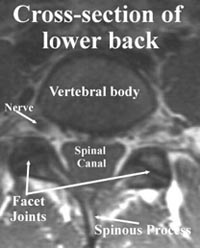 |
The spinal nerve on the left side of the picture is in the "neural foramen"--a canal or doorway for the nerve to leave the spinal canal and go out into the body. Disc herniations, bone spurs from the vertebral body and bone spurs from the facet joints can press on the nerve in the neural foramen |
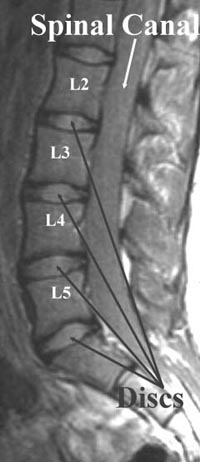 |
This shows what normal discs look like in the lower back. The central part has a significant amount of water within it and behaves something like jello or like an expensive gel-filled seat cushion.
This inner part of the disc, the nucleus, is a bright gray on these pictures. The outer part of the disc, the annulus, is a tough, fibrous layer that is strong.
It keeps the softer nucleus in place. It is dark on these pictures and looks the same as the edges of the bone. The inner part of the bone, the bone marrow, contains cells that produce red and white blood cells |
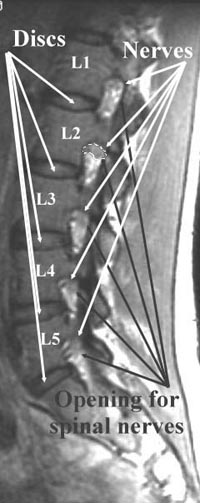 |
The spinal nerves are in the upper part of the "neural foramina", or openings or doorways for the spinal nerves, as they go from the spine to the rest of the body.
At L2 (the 2nd lumbar vertebra), the spinal nerve is circled with a white line. The bright material below the nerve is fatty tissue. |
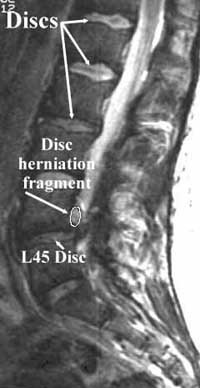 |
The L45 disc (short arrow) is not as bright as the discs near the top of the picture because it has partially dried out. Aging and injury cause a disc to lose water. The loss of water weakens the disc and decreases its "shock absorber" capabilities. In this case, a fragment of the central part of the disc has slipped backwards and upwards, to narrow the spinal canal |
 |
The fine white line surrounds the "neural foramen" or doorway through which the spinal nerves leave the spinal canal to spread out into the body. This neural foramen can be narrowed by disc herniations, spurs from the margin of the vertebral body, or spurs from the facet joints |
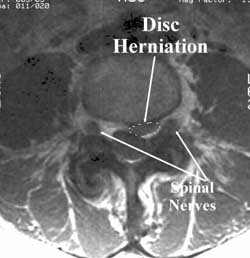 |
In this patient, a fragment of the L4-5 disc has extruded outside its normal location and is pushing into the spinal canal. |
 |
During minimally invasive surgery for disc herniation, a small endoscope with fiber optics is directed from the skin to the disc. In the picture left, the endoscope is in the L45 disc. |
|
|---|
| Do you own surgery |
|---|
 |
|---|
|
|
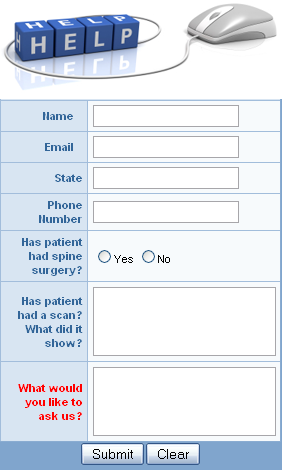
|

